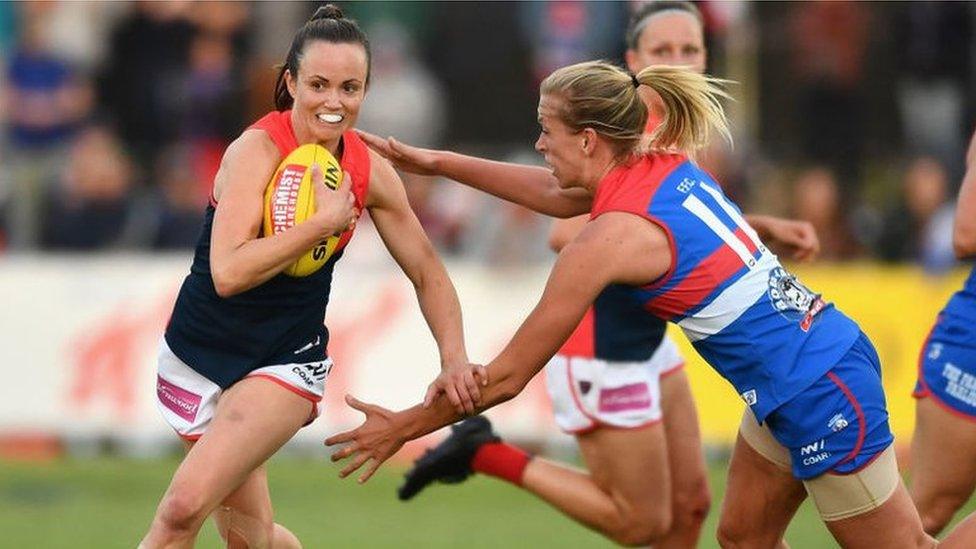Trugo: A bizarre sport unique to Melbourne
- Published

John McMahon, 89, demonstrates trugo's distinctive hitting action
Not many people have heard of trugo: a mix of croquet, golf, lawn bowls and the hammer. But, as James Bartlett writes, the unusual game that sprung from Melbourne's railway yards is trying to attract new fans.
I'm very much a part-time member of the Yarraville Trugo club, and I haven't played an official game for them yet. I probably never will, as I live nearly 13,000km (8,000 miles) from the ground.
Even so, I wear my canary-yellow team shirt with pride as I arrive.
Training has begun for the upcoming season, and there's a good turnout of players old and new.
Club captain John McMahon, 89, has already set up, and when I appear he asks "How ya going?" and offers me a cup of tea.
He's a former world (yes, world) champion at a sport that's also around 90 years old, yet it's unknown anywhere else in the world - and is even a secret to most Melburnians.
Welcome to the weird and wonderful world of trugo.
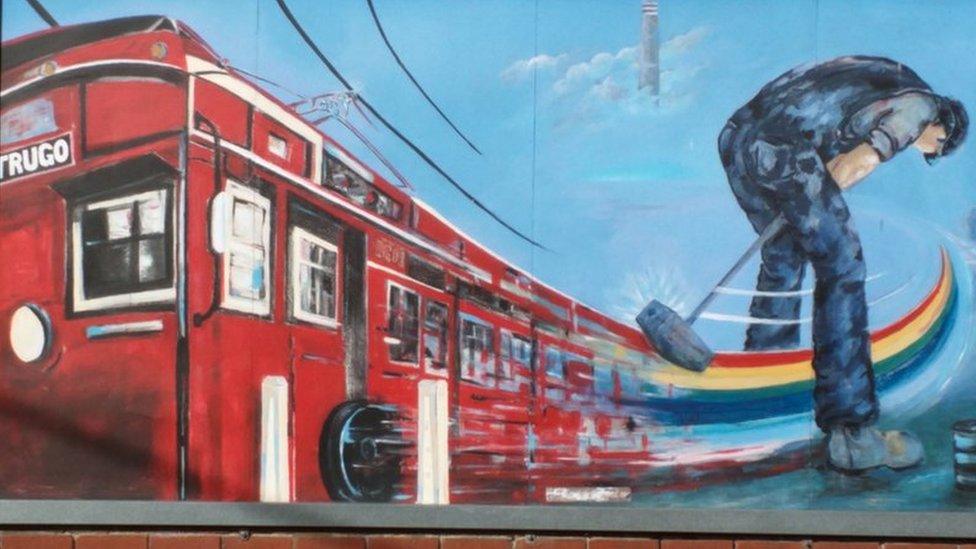
A mural by artist Peter McMahon on display in Melbourne's Yarraville
Players take a thick rubber ring, balance it upright, and then swing a rubber-tipped wooden mallet between their legs to try and hit the ring between two posts.
Oh, and you do all this facing backwards. For some reason.
Railway beginnings
Research says that trugo was invented in the late 1920s or early 1930s by Tom Grieves, a Yarraville railwayman and first president of the Victoria Trugo Association.
The story goes that he was bored one day, and started using his mallet to hit rubber rings that were used as shock absorbers inside railway buffers.
Other sources say this happened at the Newport Railway Workshops when workers were messing around during a lunch break, though The Melbourne Herald of 23 March 1950 quotes a councillor Aleck Beaton saying Mr Grieves alone took buffers into a local park and started hitting them with his croquet mallet.
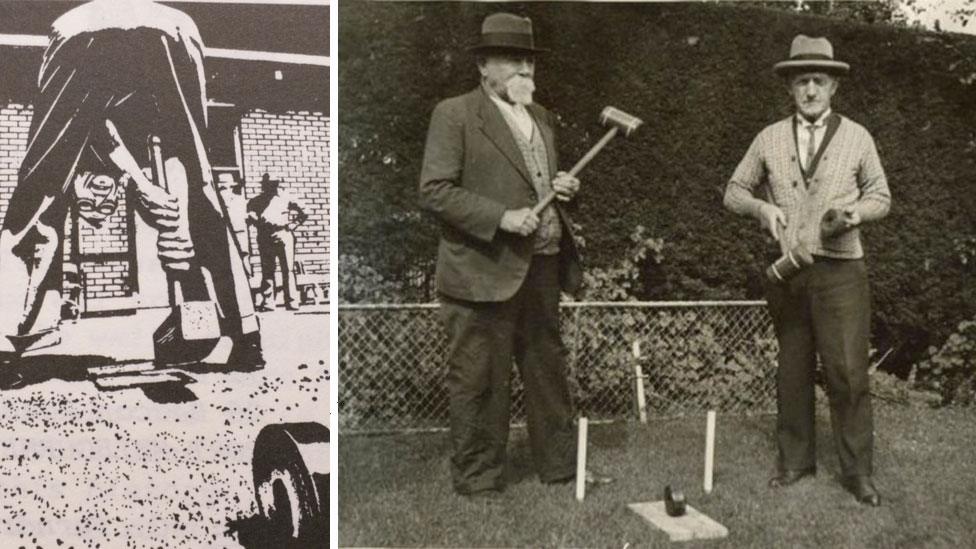
Trugo is thought to have developed in Melbourne in the early 20th Century
Trugo only left the railway yards when retirees took it to their local parks, and Welco Rubber in Tullamarine still uses the same tooling to make the rings - just as they have been doing since the 1930s.
Mr McMahon's father was a signalman, and he joined him in playing when he retired early in 1991, as early rules said that players had to be 60 and older.
"A doctor told me trugo has added 10 years to my life," laughs Mr McMahon.

You might also like:

No matter where it originated, the rules are based around the railway world.
The length of court is that of the city's famous "Red Rattler" trains - about 30m (90ft) - and those goal posts are positioned the width of a railway track apart, with "Catchers" holding a large cloth butterfly net in readiness behind them.
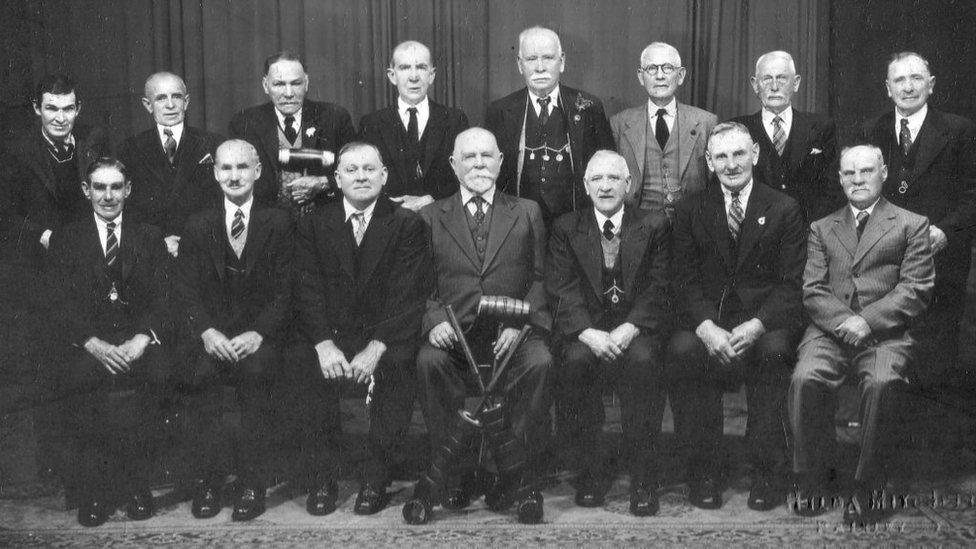
Men described by the Victorian Trugo Association as the sport's founders
As for why the sport stayed in the western suburbs, that's probably because many of the workers lived along the lines that ran out of Flinders Street, the first railway station in Australia.
Engaging the young
Women were later admitted to play and had their own leagues, though dresses and skirts led to many whacking the ring like golf, and so they were christened "sideswipers".
Today all teams are mixed, and all players are "tunnellers".
Last year Mr McMahon's daughter, Cheryl Waldon, 63, won the World Championship.
"I wasn't even expecting to play that day," she confesses, "so I just relaxed and had fun."
She was at training along with her young granddaughter Winter, and a group of children from a local nursery school. Mr McMahon had made them a kind of training-wheels-for-trugo set, and they seemed set to be the next generation.
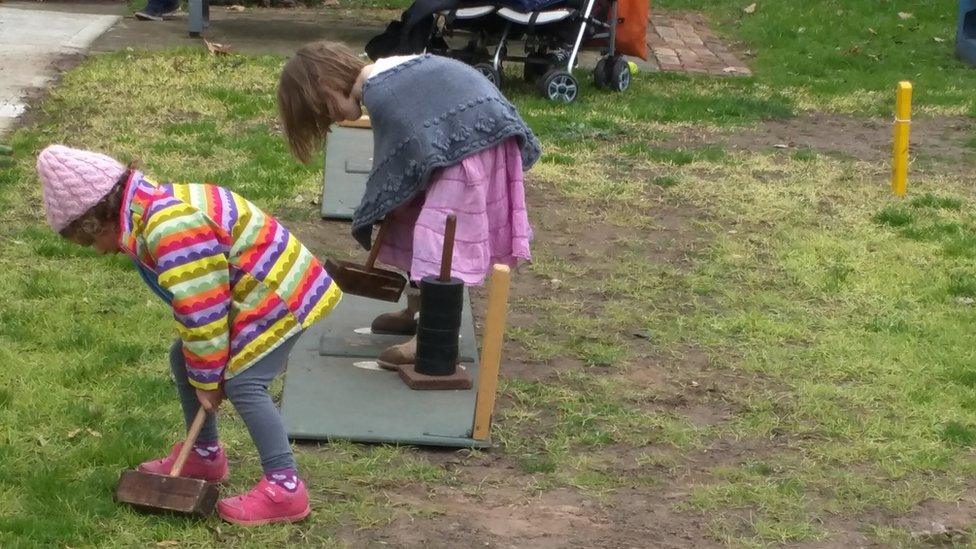
Trugo clubs hope to find a new generation of players
Young students with disabilities have come here to learn the game too.
The court is often hired for a game of trugo and a party, though dedicated younger players are thin on the ground, mainly because training is strictly on weekday mornings, and many people simply aren't free.
That schedule is something Ms Waldon, the energetic new president, is looking to try and change. She's beefed up the club's social media presence, and regularly posts pictures online.
At the height of its popularity there were 13 clubs, but it was always fighting competition from Australian rules football and "the pokies" (slot machines), says Mr McMahon with a grimace. Funding was also hard to come by.
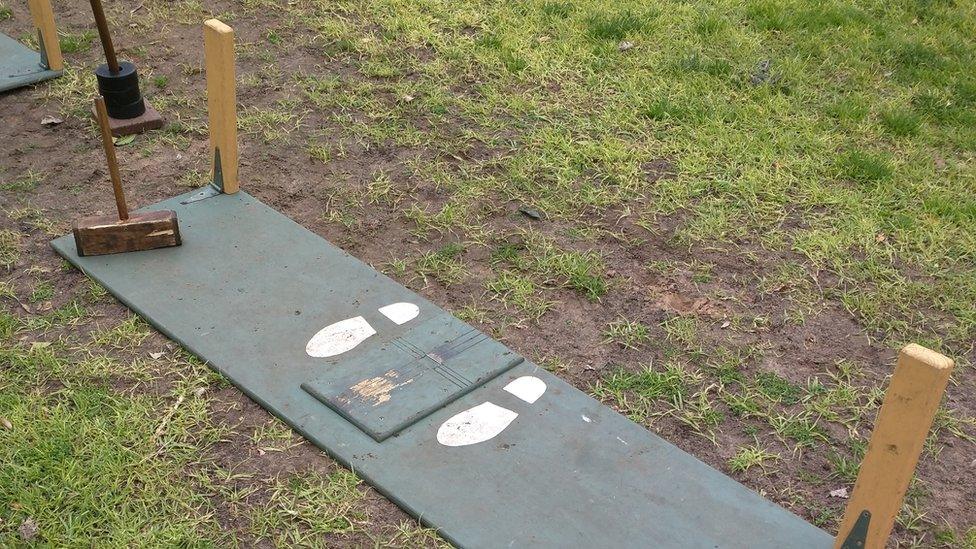
Players take a thick rubber ring and balance it upright between their legs
There have been moments in the spotlight though. In 2003 a Dutch comedian visiting Melbourne arranged a game to be played via webcam at a comedy festival in his homeland, and in 2009 Anthony Bourdain was brought here as part of his series "No Reservations".
'Give it a true go!'
Of the seven clubs left today, many are still idyllic: grass courts, trophy-lined wooden pavilions, and (in my experience at least) pies and a bottle of local beer after practice. Footscray - the second-oldest - recently reopened after being closed for many years, and all of them welcome people who want to give trugo a try - or "have a hit".
The maximum individual score per league game is 24, but that's a rare occurrence these days and players who hit that target for Yarraville are immortalised in a special score book kept under glass.
Mr McMahon managed it three times in six weeks in 2000, the year he was world champion, but the last one was Malta-born Bill Bajada, who managed the feat twice in 2016.
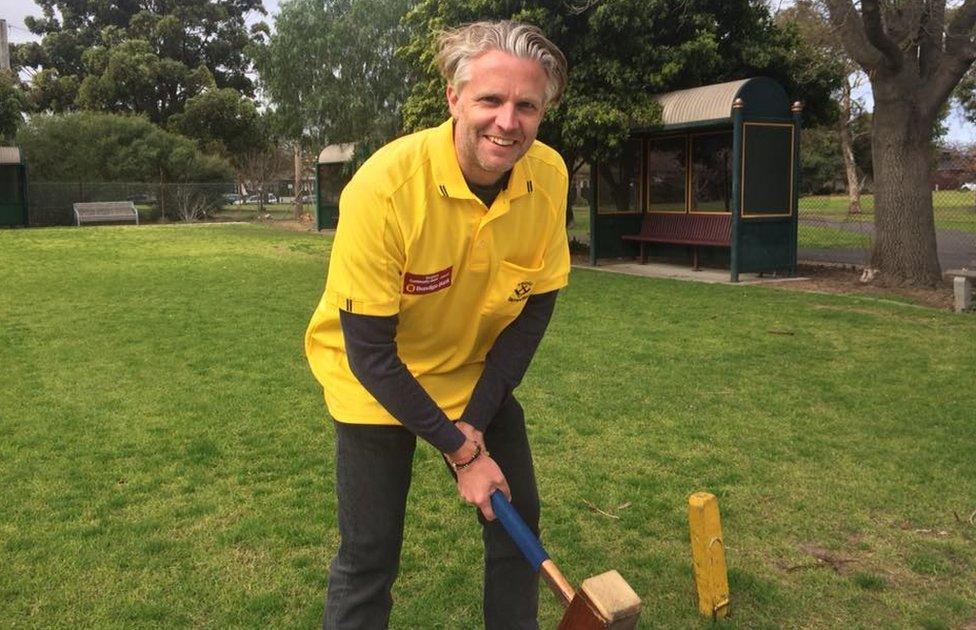
James Bartlett gets his head around trugo
As for the unusual name, that seems to be a combination of the initials of the inventor - TG - and the supportive cheer to "give it a true go!".
As the mynas and parrots squawked overhead, I was thrilled to hear the solid "thwack" of mallet on rubber as I consecutively hit four points in a row, but then my ninth ring went skewing embarrassingly off to the left, and I scored zero out of four in that round.
Mr McMahon simply laughed: "Trugo's easy to learn, though I still haven't got it right after 27 years."
During the session I heard the other players use the words "Dickie", "Mary", and "Postie", but I still don't know what the first two meant - though a sense of humour is vital if you want to play.
Guess I'll have to wait for next year's trip to Melbourne.
- Published1 August 2017
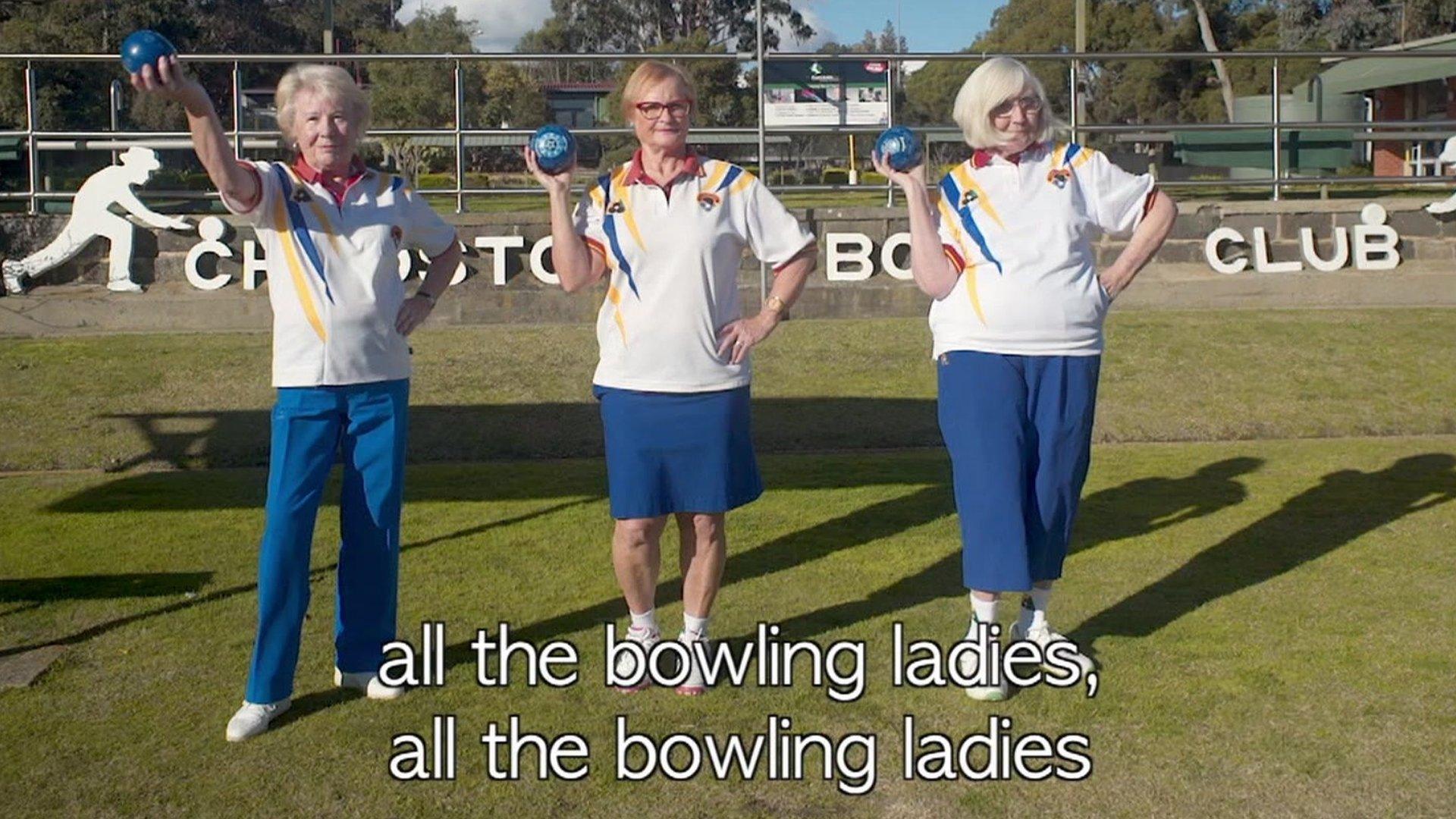
- Published3 March 2017
